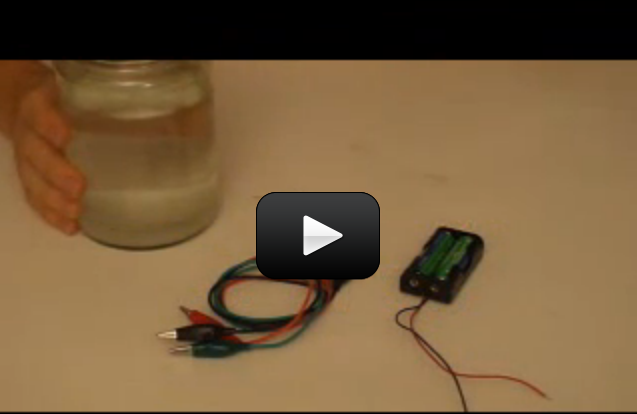When an atom (like hydrogen) or molecule (like water) loses an electron (negative charge), it becomes an ion and takes on a positive charge. When an atom (or molecule) gains an electron, it becomes a negative ion. An electrolyte is any substance (like salt) that becomes a conductor of electricity when dissolved in a solvent (like water).
This type of conductor is called an ‘ionic conductor’ because once the salt is in the water, it helps along the flow of electrons from one clip lead terminal to the other so that there is a continuous flow of electricity.
This experiment is an extension of the Conductivity Tester experiment, only in this case we’re using water as a holder for different substances, like sugar and salt. You can use orange juice, lemon juice, vinegar, baking powder, baking soda, spices, cornstarch, flour, oil, soap, shampoo, and anything else you have around. Don’t forget to test out plain water for your ‘control’ in the experiment!
Please login or register to read the rest of this content.


What a great solution! Thanks so much for the tip, Kathy.
hi this is kaseyhH {I am 11 years old} me and my mom could not find LED lights so we used Christmas lights, and they worked great. So for you who can’t find them use Christmas lights
Parsley is considered low in salt, but nowhere did I read it was salt free, so perhaps the low sodium content of parsley provided a weak electrolyte. I did find that parsley increased electrolyte and water secretion in rat colons….doesn’t answer their question, but anything about parsley and rat colons must be passed along. Water itself can act as a weak electrolyte, especially if it is tap water instead of distilled water.
I just did this experiment and was wondering if parsley would be an electrolyte or did my light go on because of the water? This is from Chapter 10 circuit experiments. Salt made the light shine brightest. Chicken boullion had the same effect as the parsley.
Although sugar and salt LOOK the same, they are not the same molecule. Salt is NaCl, which splits into Na+ and Cl- when mixed with water (these are called ions), and when the ions move through the solution, they allow current to flow through your circuit. THere’s a lot more detail about this right under the experiment and in the reading for Unit 8 Lesson 2.
The sugar dissolves, but does not form ions, so you get sweet-tasting water that does not conduct electricity. Which is exactly what you found. SO, from one scientist to another – great job! 🙂 Seriously!
We tried sugar since we saw you use salt in the video. It doesn’t work. Should sugar work?
You’re right – most people are surprised when water doesn’t work to light up the bulb… yet they still recall that water conducts electricity. The trick here is quantity – the amount of electricity needed to light up the LED isn’t making it through the plain water, which is why you need to add an electrolyte to help it out. The electrolyte carries the charge from one terminal to the other in the solution. Have you tried substituting vinegar for the water? How about orange juice? What else in your fridge conducts better than water?
Water shouldn’t work all that well, and depending the LED, it may not work at all. You can try a flashlight bulb in place of the LED, as sometimes LEDs are hard to see when they’re only illuminated a tiny bit (you have to look at it straight-on from the top in the dark). When you added the salt, the light should have gotten a bit brighter, but it won’t be nearly as bright as when you touch the ends together. You can try other things in place of the salt to see if you get better results.
Hi!
We cannot get the electrons to go through water. Everything is hooked up correctly. The LED lights up when we touch the lead ends together. But, when we put them into water, the LED does not light up. We added a LOT of salt (little bit at a time) and the LED lights up only a little bit (just part of it is glowing). What could be wrong?
Thank you!
Why doesn’t water work? Water should conduct electricity but the light does not go on with plain water and it is very dim with salty water.